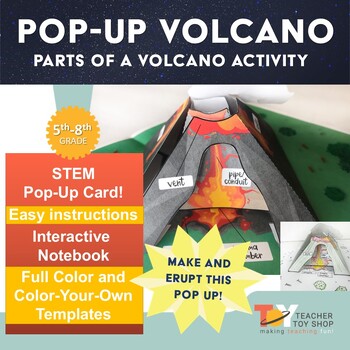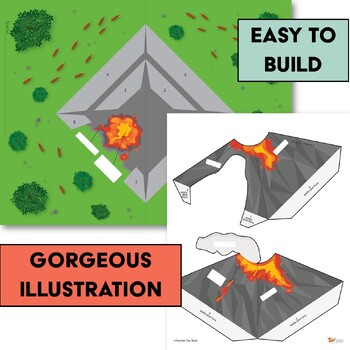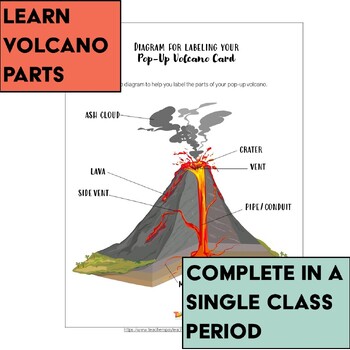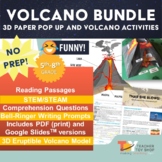Volcanoes Natural Disasters Earth Science Activity - STEM Pop-Up Card
- PDF
- Easel Activity
What educators are saying
Also included in
- Access a comprehensive array of Earth Science resources with Earth Science Activities and Lesson Plans Bundle, curated by Teacher Toy Shop! This all-inclusive bundle provides educators with a wealth of engaging materials to enrich their Earth Science curriculum. From science worksheets to hands-on sPrice $16.00Original Price $23.49Save $7.49
- These resources teach students about where, how and why volcanoes erupt. Includes a wow volcano project for kids in addition to a FUNNY reading passage with assessment questions and bell ringer writing prompts. The 3D paper volcano makes a fabulous interactive notebook page. It can also be used as aPrice $6.49Original Price $7.99Save $1.50
- Looking to end the school year with a bang? These WOW end-of-school activities and science projects only require 1, 2, or 3 class periods each to complete. Classroom already packed up? No problem—you need only paper, scissors, glue and/or tape to complete these projects. Keep students engaged and lePrice $19.99Original Price $26.94Save $6.95
Description
Immerse your students in the fascinating world of volcanoes and natural disasters with this STEM Pop-Up Card Activity! Bonus: it makes a great Father's Day Card!
This hands-on project offers an engaging way to explore the dynamics of volcanic activity while reinforcing key concepts in earth science. Students have the opportunity to construct and label their own 3D volcano, fostering both tactile learning and visual comprehension. Whether incorporated into interactive science notebooks or utilized as an educational gift, this activity provides a memorable learning experience on volcanic landforms. It can be completed in just one class period.
Included in this comprehensive package are printable files for creating the 3D volcano, along with simple step-by-step instructions and a helpful video tutorial. Students will learn to identify and label essential parts of the volcano, including the ash cloud, crater, lava, magma chamber, and more. With additional instructions for conducting a volcanic eruption experiment using baking soda and vinegar, students can witness the eruptive process firsthand, deepening their understanding of volcanic phenomena.
Versatile in its application as a volcano craft, this activity can be integrated into various educational contexts, from earth science units to STEM or STEAM crafts, Earth Day activities, and even holiday-themed cards for occasions like Valentine's Day or Mother's Day.
Whether utilized in traditional classrooms or adapted for distance learning or homeschoolers, this volcanism resource offers flexibility and accessibility for educators and students alike.
Spark curiosity and exploration in your classroom with Volcanoes Natural Disasters Earth Science Activity STEM Pop-Up Card and ignite a passion for scientific discovery that extends beyond the classroom walls.
► What's Included?
- 3D Volcano Printable Files
- Simple (3-step) instructions for making the volcano craft PLUS a link to watch a video showing how to make it
- Instructions for labeling the parts of the volcano: ash cloud, crater, lava, magma, magma chamber, pipe or conduit, vent, and side vent.
- Parts of the Volcano Diagram
- Answer Key
- Instructions for erupting the volcano
- EASEL digital drag-and-drop activity in which students label the parts of the volcano
You Might Also Like...
- Volcanoes, Earth's Layers and Plate Tectonics Activities
- Parts of a Flower STEAM Activity
- Rocks and Weathering Science Homework Experiment
- Giant Bundle of Science Homework Experiments Digital & Print | Distance Learning
⚠️ BUNDLE & SAVE! ⚠️ Get ALL of Teacher Toy Shop's Earth Science Resources and SAVE with this Earth Science Bundle!
✪ Don't forget to follow Teacher Toy Shop to be the first to know about new products, sales and freebies!









